Featured
Talking transit with Streetsblog
July 28, 2011
 From “people powered transportation” to the Westside subway, I tackled a wide-ranging series of questions this week from readers of Streetsblog Los Angeles on our region’s pressing transit challenges—past, present and future.
From “people powered transportation” to the Westside subway, I tackled a wide-ranging series of questions this week from readers of Streetsblog Los Angeles on our region’s pressing transit challenges—past, present and future.
Among many other things, I called for a break with “dated, auto-centric models” in favor of bicycling, walking and public transportation. I explained why I believe it is imperative that we finally bring mass transit to the Westside in the form of projects such as the Exposition Light Rail and the Westside Subway Extension. And I offered my views on the tensions that have erupted between Beverly Hills and Metro on the subway’s route, stressing that decisions will be based on evidence and science, not emotion.
Looking farther down the road, I talked about the possibility of someday building a 405 rail corridor between West Los Angeles and the San Fernando Valley and extending the Red Line subway through West Hollywood.
For the full text of my two-part Q & A with Streetsblog, you can click here for the first segment on regional transit needs and here for the second one on cycling and pedestrian issues. Feel free to let me know what you think at [email protected]
Posted 7/28/11
Let’s step out of the fast lane
July 20, 2011
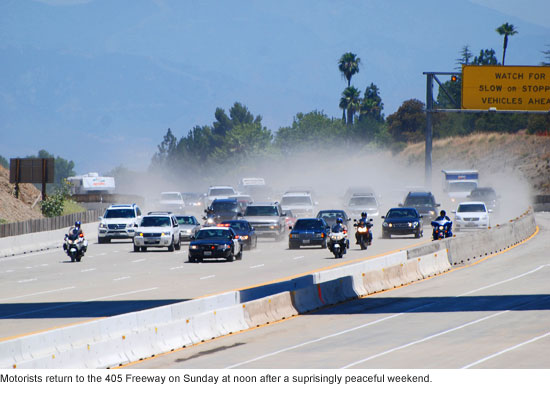 My apologies to New Orleans, but last weekend it was Los Angeles that deserved the nickname “The Big Easy.”
My apologies to New Orleans, but last weekend it was Los Angeles that deserved the nickname “The Big Easy.”
Did you feel it, that strange but satisfying calmness that descended on our roads and neighborhoods, that sense of collective purpose? The closure of the 405 Freeway could have been the mother of all traffic nightmares. Instead, it became a moment to savor—and ponder.
Not since the 1984 Olympics, nearly three decades ago, have our freeways been so blessedly empty. You responded overwhelmingly to our warnings (Carmageddon anyone?) with such incredible results that we now find ourselves in a wholly unexpected discussion. That is: short of jack-hammering a freeway, would it actually be possible to shutdown traffic more regularly, like other countries, to reconnect to a simpler, easier life?
There’s certainly a pent-up craving for it. Look at the overnight popularity of the CicLAvia events. Thousands upon thousands of pedestrians and cyclists of all ages, sizes and colors have flocked to the seven-mile route that snakes through city streets between Hollywood and the Eastside. Created more than 30 years ago in Bogota, Colombia, there have been just two here so far. But another is scheduled for October, and I suspect the turnout will be even larger.
Short of big events or road closures, maybe we could start modestly by simply choosing to spend more weekends closer to home with family and friends, as so many of you did on Saturday and Sunday. One of my staff members told me that for her and her 2-year-old daughter, a simple stroll around the block led them to a lively gathering of neighbors at an open house. Some of those folks she met for the first time—the start of new friendships.
Of course, there are other ways to tame our traffic and preserve our nerves. Why not explore the region by using public transportation? Wherever you want to go, Metro’s online trip planner will get you there. I know you’ve probably heard this suggestion before. But maybe now, in the afterglow of last weekend, is a good time to experiment.
For me, the truth is that I have more questions than answers about how we can decompress a region so packed with stress. But this I do know: we should not let last weekend simply fade away into L.A. traffic lore. These are the kinds of shared moments that can trigger change. Let’s keep the discussion going. Drop me a note with your thoughts at [email protected] and I’ll write about them in the weeks ahead.
Posted 7/20/11
Here we go
July 14, 2011
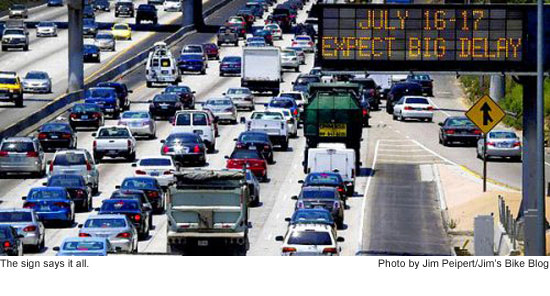 Yes, it’s finally here, “Carmageddon” weekend.
Yes, it’s finally here, “Carmageddon” weekend.
I feel confident that, by now, you know what I’m talking about. And that’s a testament to the extraordinary outreach efforts of our state and local transportation officials. Now, it’s up to us to help make sure that the 53-hour closure of the 405 Freeway isn’t any worse than it absolutely must be.
Of course, the best thing we can do is stay out of our cars for a couple days. But if you must hit the road, then please check the traffic reports and stay cool. There’s no need to see red (except for brake lights) if you leave early and are prepared for the frustrations of traffic. We’ve pulled together some basic information to help you on your way, which you’ll find here as part of our 405 Report. And if you’re looking for things to do—maybe 53 of them—check this out.
Meanwhile, I hope you’ll visit my website throughout the weekend. I’ll be blogging live, giving you my view of the unfolding events. I encourage you to upload photos of what you see out there to a special “Carmageddon” album we’ve created on the website’s “Picture This” feature.
I’ll also be posting updates on my Twitter and Facebook pages, so please drop by. No doubt, this will be a memorable weekend in L.A.’s traffic history. Let’s do our best—together—to make those memories good ones. Thanks for reading and, as always, you can reach me at [email protected].
Posted 7/14/11
Something to cheer about
June 23, 2011
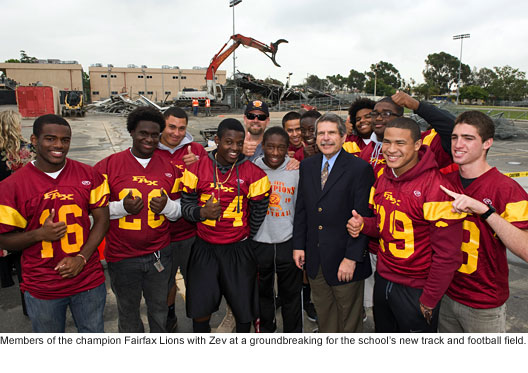 When Fairfax High principal Ed Zubiate arrived at my alma mater in 2006, he had no intention of simply running in place. He was determined, of course, to lift the school’s academic standing. But he also was committed to an ambitious brick-and-mortar project: rebuilding the school’s aging track and football field.
When Fairfax High principal Ed Zubiate arrived at my alma mater in 2006, he had no intention of simply running in place. He was determined, of course, to lift the school’s academic standing. But he also was committed to an ambitious brick-and-mortar project: rebuilding the school’s aging track and football field.
Back in the mid-1960s, when I was on Fairfax’s cross-country team, I remember endlessly circling that well-trod dirt oval, which by then was already some 40 years old. And that’s the same track used by the school’s current crop of competitors, with virtually no improvements since the campus opened in 1924. As you might imagine, the decades have not been kind—as I know from dodging ruts when I run there today.
Principal Zubiate found this state of affairs ripe for tackling for reasons that transcend footraces and grandstands. As he told a local newspaper last year: “We wanted a school that physically reflected what we think we are on the inside, something the community could take pride in.”
To that end, he initiated an innovative fundraising drive that has been hailed as a model for other campuses in these days of disappearing dollars. For starters, he recruited Joyce Kleifield as the campus’ “development director”—a job usually associated with private schools—and got the non-profit Greenway Arts Alliance to generously pay her salary. Together, the two then reached into the community for donations and services they hoped might shake loose more government funding.
The American Youth Soccer Association, better known as AYSO, agreed to provide public programs valued at $1 million, an amount that enabled Fairfax to receive $2.6 million in voter-approved Los Angeles Unified School District bonds. The Faro Foundation, meanwhile, kicked in $500,000. Given assurances that the new facility would be open to the public at night and on weekends, my office contributed $250,000 in county funds.
Last Friday, the principal’s $6-million dream moved a huge step closer to reality when ground was broken for the new athletic facility. Scheduled for completion in 2012, there’ll be a rubberized track, synthetic field and a new grandstand for the Fairfax High Lions. On hand, among others, were proud members of the football team, who last year won a city championship in their division.
I recently saw Mr. Zubiate quoted as saying: “This is my greatest accomplishment in 30 years with LAUSD. It’s not just the money we raised but the relationships we created.”
How’s that for a winning attitude?
The principal has not only elevated the school’s academics and athletics, he has sent a clear and optimistic message to the neighboring community and beyond: Even in these most trying of times for our public institutions, so many seemingly insurmountable hurdles can be cleared with commitment and creativity. And that’s something to cheer about.
Posted 6/23/11
A time to dream big
June 15, 2011
 Whether you’re wearing a cap and gown or just sitting proudly in the audience, graduation season offers a hearty dose of uplift. And for those of us invited to join the festivities as commencement speakers, as I recently was at Monroe High School, where my son graduated more than a decade ago, it’s also chance to reflect on some of the life lessons that have mattered most to us over the years. Here are a few of mine, excerpted from my remarks at Monroe.
Whether you’re wearing a cap and gown or just sitting proudly in the audience, graduation season offers a hearty dose of uplift. And for those of us invited to join the festivities as commencement speakers, as I recently was at Monroe High School, where my son graduated more than a decade ago, it’s also chance to reflect on some of the life lessons that have mattered most to us over the years. Here are a few of mine, excerpted from my remarks at Monroe.
—
We’re fond at these commencement exercises of quoting Mark Twain. He once said, “Don’t let your schooling interfere with your education.” I know from personal experience with my own son that Monroe not only offered a great schooling, but one heck of a good education. An education in the real world; in the development of friends and relationships that have lasted him for these last 11 years, and will last a lot longer.
As you get further away from this day, you’ll realize that there are three, four, maybe five teachers that you had who made a difference in your life in one capacity or another. I still think of my high school teachers, the one who taught me how to write a composition, the one who taught me how to think logically in plane geometry. My track coach, Mr. Balzarett, who was also the track coach here at Monroe for many, many years, maybe had as much influence on my life as any single human being, to give me the sense that I could do whatever I wanted to do. Those kinds of relationships, and those kinds of mentors, are people who will have an influence on your life for years and decades to come.
Don’t let yourself, and don’t let anybody else, get in the way of you dreaming big dreams and working hard to achieve them. Don’t let anybody tell you that you can’t be what you want to be. Each one of you, whether you want to be a police officer, a probation officer, a teacher, a scientist, a mathematician, whatever you want to be, don’t let people discourage you. This city needs young men and women like you, to reinvest your heart and soul in the city and in the county—to help kids, to help the homeless, to get them homes, to help clean up our communities, to help educate our children, to help make our communities safe. You can play a critical role in making this an even better city than the one that you are going to inherit in the years ahead.
Don’t let anybody hold you back. Make a difference in your life, and more importantly, make a difference in your neighbor’s life.
Posted 6/15/11
Rx for a 405 headache
June 2, 2011
 Allow me to be blunt: it’s going to be a mess out there.
Allow me to be blunt: it’s going to be a mess out there.
As you may have heard, the 405 Freeway is being shut down through the Sepulveda Pass for 53 hours next month to accommodate demolition of the Mulholland Bridge, part of a massive freeway-widening project. The closure—an essential safety precaution—will begin before midnight on Friday, July 15th, and continue into the pre-dawn hours of Monday, July 18th.
Each weekend, roughly 500,000 vehicles move through this stretch of freeway, where detours are difficult to map and navigate because of the area’s mountainous geography. Beyond the obvious traffic implications, life for residents and businesses in the 10-mile impact zone will be challenging, at best. As the county supervisor for this district, my office has been working closely with the project team, and I assure you that we’re committed to doing everything we can to anticipate and ease the pain for all.
But the truth is that we must work together by planning now.
Obviously, the best way to steer clear of the aggravation zone and reduce congestion is to stay home that weekend or make plans in the neighborhood, like catching a movie at the local theater. If you’re supposed to work, try to change your schedule, take a couple vacation days or telecommute.
If you must hit the road, chart a course using the region’s many other freeways. You may end up driving more miles, but I guarantee you’ll get to your destination faster than by gambling on 405 detours that could leave you stuck for hours.
For those of you who think you can outsmart this potential mother of all traffic jams, my advice is simple: save your gas. After representing the San Fernando Valley and Westside for more than three decades as a Los Angeles city councilman and county supervisor, I know virtually every shortcut in those parts—and none will work because of the sheer volume of vehicles being taken off the freeway.
In the days and weeks ahead, you’ll be hearing lots more about the 405 closure from the folks at Metro, who are not only spearheading the construction project but launching a massive public outreach campaign. We don’t want anyone surprised by the enormity of the undertaking and its inevitable fallout. (For Metro’s latest information on the I-405 Sepulveda Pass widening project, click here.)
It’s been my experience that, armed with the facts, Angelenos can be very enterprising, especially when it comes to their roads. Just think back to 1994, after the Northridge Earthquake, when a portion of the Santa Monica Freeway collapsed and was closed for nearly three months. Yes, there was plenty of frustration but motorists adapted and coped. While this upcoming closure will be a pain, it’s only for a weekend. So if you roll with the realities, you’ll avoid a trunk load of aggravation.
For more, listen here to my KPCC interview with Larry Mantle on AirTalk. Also, visit the special “405 Report” section of my website and follow my freeway updates on Twitter and Facebook.
Posted 6/2/11
When every second counts
May 11, 2011
The email from my sister started with the words: “He’s going to be OK.”
If she hadn’t opened that way, I’m not sure I could have kept my composure as I read what followed:
My 12-year-old great-nephew had been hit by a car as he walked home from school with friends in Brookline, Mass. The driver stopped and was screaming desperately for help when a retired 79-year-old U.S. Coast Guard captain named David Flanagan came on the scene, driving home after a gym workout with his wife.
When Capt. Flanagan saw that my great-nephew wasn’t breathing and had no pulse, he methodically started performing CPR. Happening upon the accident scene within minutes, perhaps even seconds, of the accident may have saved my great-nephew’s life. At the very least, it helped spare him more serious complications from a crash that, as it is, left him with a broken femur, a cracked skull and a major concussion.
Paramedics showed up shortly after, and our “first responder” didn’t hang around for thanks or acknowledgement as my great-nephew was rushed to the renowned pediatric trauma center at Children’s Hospital Boston.
I’m telling this story not just to publicly thank Capt. Flanagan—who despite his modesty represents remarkable courage, decency and skill—but also to marvel at what a difference having rapid access to skilled trauma care can mean, especially for children.
As we voted this week to distribute funds to our county’s trauma and emergency care network, including $1.6 million in startup operating funds for Northridge Hospital’s new Richie Pediatric Trauma Center, my great-nephew’s brush with disaster reminded me of what an important investment that is. The Richie center is the only facility of its kind serving the vast San Fernando Valley, and one of just seven offering this specialized, vitally important care in the entire county. Before the Richie center opened last year, some 300 kids annually had to be transported from the Valley to Children’s Hospital in Hollywood or UCLA’s pediatric trauma center for care. Sacramento has contemplated shifting funds from such trauma centers to help bridge its severe budget gap, but clearly we cannot afford to erode our emergency and trauma network any further.
The “golden hour” in medicine refers to that brief window of time when medical attention can mean the difference between a good outcome and a tragedy. For kids, that window is even smaller because they’re generally less able to compensate for injury and blood loss as effectively as adults. For them, the most good can be done during the “platinum half hour”—and in an area as spread out as the San Fernando Valley, this life-saving resource is long overdue.
My great-nephew spent five days in the hospital and now is back home and on his way to a full recovery. He’ll miss school for several weeks and will be in a wheelchair for a couple of months. Over the phone, I joked with him that the accident had given him good material for his college application essay. He joked back about the Lakers’ playoff humiliation.
I can’t say enough about how much it meant to be able to kid around with him, and how grateful I am to Capt. Flanagan and the professionals who made it possible. (It made all the difference that the captain knew CPR—a reminder to all of us that this is a skill worth learning, and refreshing, at classes offered regularly by the American Red Cross throughout Los Angeles County.)
Of course, we can’t guarantee there’ll be a CPR-trained Good Samaritan passing by every time a kid gets hurt. But by providing funding to the newest member of our county’s pediatric trauma care network at Northridge Hospital, we can greatly improve the odds of injured children getting the help they need—when they need it the most.
Posted 5/11/11
Fateful times in the capital
May 5, 2011
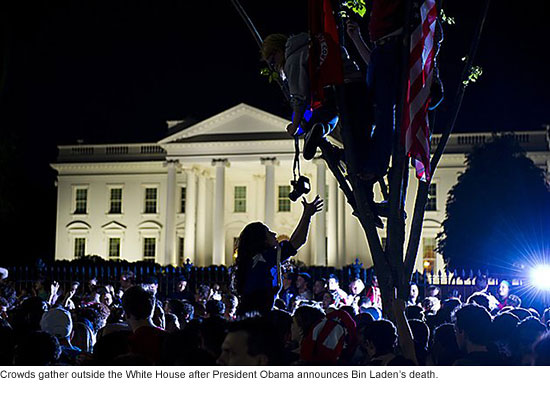 I arrived in Washington D.C. just hours after news broke that Osama Bin Laden was found and killed in Pakistan. The stunning revelation instantly transported me back nearly a decade, to another lobbying trip I’d made to the capital with Los Angeles County officials.
I arrived in Washington D.C. just hours after news broke that Osama Bin Laden was found and killed in Pakistan. The stunning revelation instantly transported me back nearly a decade, to another lobbying trip I’d made to the capital with Los Angeles County officials.
The date was September, 10, 2001. The next morning all hell broke loose in New York, Washington and Shanksville, Pa.
To this day, I can still hear the wail of sirens racing towards the Pentagon. Washington was shut down, with military personnel stationed at key intersections and in front of important government buildings. We were essentially quarantined in or around our hotel.
I vividly remember wondering who would have hatched this murderous conspiracy and why?
The “why” it was done may be a subject for debate and analysis for years. And although the “who” was known to the world pretty quickly, it took nearly 10 long years to find and rid the world of this menace who perpetrated the acts of 9/11.
When I arrived in Washington this week, the mood was not one of elation but rather one of satisfaction that this piece of unfinished business was now suddenly and unexpectedly erased from our national agenda. Frankly, that’s how I felt. I didn’t celebrate, but I was deeply proud of our nation, its leaders and the men and women in uniform who put their lives at considerable risk for us.
Although the news media understandably continues to be dominated by the killing of Bin Laden, the truth is that a sense of normality returned to Washington only hours after the Navy SEALS had returned to their base. Our trip, in fact, turned out to be one of the most productive I can remember.
A relatively small group of county leaders from throughout the nation, myself included, spent five hours at the White House on Tuesday, meeting with the President, the Vice President, five cabinet secretaries and several key administration officials. The subjects included preservation of Medicare/Medicaid, funding for the subway extension and other transit projects, and how to break the cycle of jails and poverty.
We also spent considerable time meeting with California’s congressional delegation, including our two senators, Dianne Feinstein and Barbara Boxer. Our federal representatives have always been attuned to our county’s needs and accessible to us, and it was no different this time.
I’m often asked what we accomplish on these lobbying visits. I like to think of us as salesmen working our territory. Our product, so to speak, is the County of Los Angeles. It may take some time to know whether we were able to close the deal for the vital resources we need, especially for those individuals marginalized because of poverty, health or other reasons. One thing I can say for sure: failure to work our turf is a guarantee that we will not make the sale. This visit will be a success.
One last thought as I prepare to board my plane home: God bless our service men and women, and God bless our nation.
Posted 5/5/11
Setting boundaries
April 29, 2011
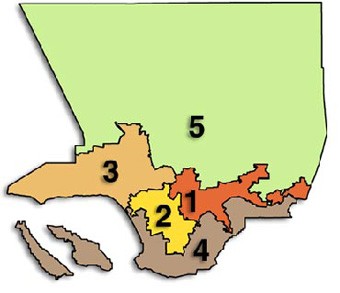 Every ten years, following the federal census, we undertake a process to ensure that Los Angeles County residents are equitably represented in the five districts of the Board of Supervisors. This redistricting process—mandated by federal, state and local law—is now underway.
Every ten years, following the federal census, we undertake a process to ensure that Los Angeles County residents are equitably represented in the five districts of the Board of Supervisors. This redistricting process—mandated by federal, state and local law—is now underway.
Across the county, a series of public meetings are being held with the Boundary Review Committee, whose members are appointed by the board. A website also is up and running with mapping tools so this time you can draw your own lines, with access to a truly remarkable level of demographic information.
We on the Board of Supervisors have until the fall to approve any changes in the existing boundaries, but we expect to take action by the end of August.
So now is the time to participate and be heard. For a lineup of meetings in the Third District and elsewhere, as well as how to contact the review committee directly, please visit the county’s redistricting website. Thanks.
Posted 4/29/11




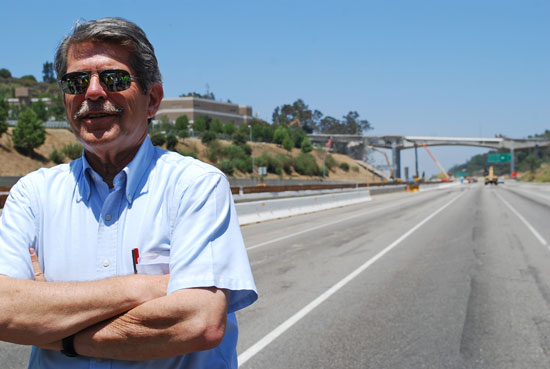
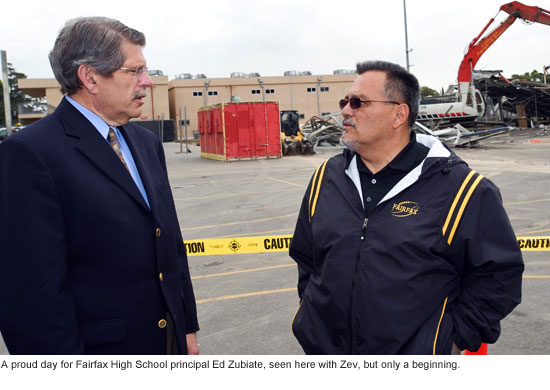
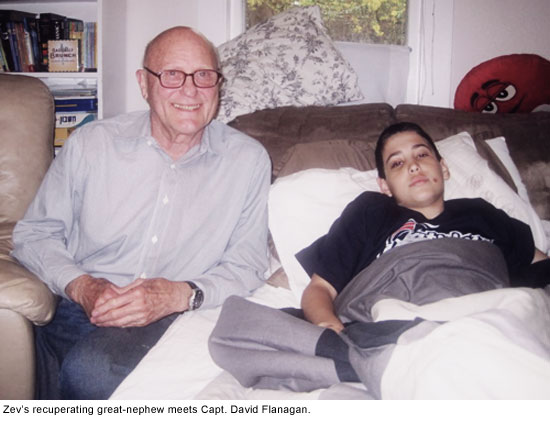





 Check for the latest closure information
Check for the latest closure information








